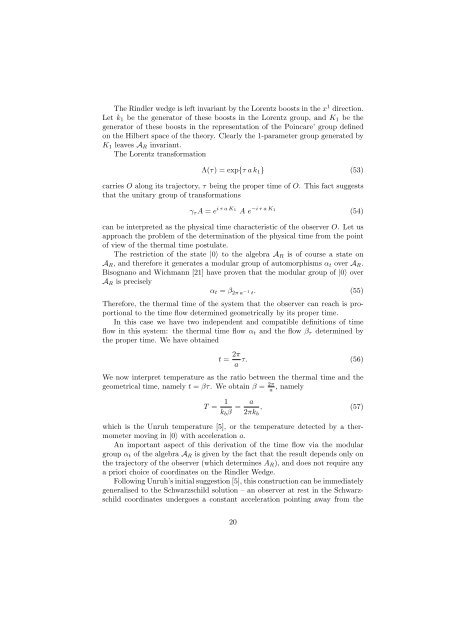Von Neumann algebra automorphisms and time ... - Alain Connes
Von Neumann algebra automorphisms and time ... - Alain Connes
Von Neumann algebra automorphisms and time ... - Alain Connes
You also want an ePaper? Increase the reach of your titles
YUMPU automatically turns print PDFs into web optimized ePapers that Google loves.
The Rindler wedge is left invariant by the Lorentz boosts in the x 1 direction.<br />
Let k1 be the generator of these boosts in the Lorentz group, <strong>and</strong> K1 be the<br />
generator of these boosts in the representation of the Poincare’ group defined<br />
on the Hilbert space of the theory. Clearly the 1-parameter group generated by<br />
K1 leaves AR invariant.<br />
The Lorentz transformation<br />
Λ(τ) = exp{τ a k1} (53)<br />
carries O along its trajectory, τ being the proper <strong>time</strong> of O. This fact suggests<br />
that the unitary group of transformations<br />
γτ A = e i τ a K1 A e −i τ a K1 (54)<br />
can be interpreted as the physical <strong>time</strong> characteristic of the observer O. Let us<br />
approach the problem of the determination of the physical <strong>time</strong> from the point<br />
of view of the thermal <strong>time</strong> postulate.<br />
The restriction of the state |0〉 to the <strong>algebra</strong> AR is of course a state on<br />
AR, <strong>and</strong> therefore it generates a modular group of <strong>automorphisms</strong> αt over AR.<br />
Bisognano <strong>and</strong> Wichmann [21] have proven that the modular group of |0〉 over<br />
AR is precisely<br />
αt = β 2π a −1 t. (55)<br />
Therefore, the thermal <strong>time</strong> of the system that the observer can reach is proportional<br />
to the <strong>time</strong> flow determined geometrically by its proper <strong>time</strong>.<br />
In this case we have two independent <strong>and</strong> compatible definitions of <strong>time</strong><br />
flow in this system: the thermal <strong>time</strong> flow αt <strong>and</strong> the flow βτ determined by<br />
the proper <strong>time</strong>. We have obtained<br />
t = 2π<br />
τ. (56)<br />
a<br />
We now interpret temperature as the ratio between the thermal <strong>time</strong> <strong>and</strong> the<br />
, namely<br />
geometrical <strong>time</strong>, namely t = βτ. We obtain β = 2π<br />
a<br />
T = 1 a<br />
= , (57)<br />
kbβ 2πkb<br />
which is the Unruh temperature [5], or the temperature detected by a thermometer<br />
moving in |0〉 with acceleration a.<br />
An important aspect of this derivation of the <strong>time</strong> flow via the modular<br />
group αt of the <strong>algebra</strong> AR is given by the fact that the result depends only on<br />
the trajectory of the observer (which determines AR), <strong>and</strong> does not require any<br />
a priori choice of coordinates on the Rindler Wedge.<br />
Following Unruh’s initial suggestion [5], this construction can be immediately<br />
generalised to the Schwarzschild solution – an observer at rest in the Schwarzschild<br />
coordinates undergoes a constant acceleration pointing away from the<br />
20


